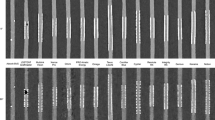Abstract
Objectives
The purpose of this study was to create virtual 3D views of the interaction between contrast-enhanced thrombi and three different types of stent retrievers.
Materials and Methods
Artificial thrombi with and without contrast agent were created and introduced into a silicone tube with saline solution. The stent retrievers (Aperio (A), Solitaire FR (B), Revive (C)) were released around the thrombi. For each retriever, two sets (0 min, 5 min) of flat panel computed tomography (CT) data were acquired on a Siemens Axiom Artis Zee biplane angiography system and reconstructed using syngo InSpace 3D software.
Results
The filaments of all three stent retrievers were displaced by the thrombus immediately after deployment. Another study series after 5 min showed further expansion of the stents into the thrombus. A tends to appose best around obstacles. A and B allow cushion-like bulging of clot material into the stent lumen. C showed only moderate curvilinear bulging and a minor degree of interaction in between stent filaments and thrombus.
Conclusions
Flexible design allows better apposition of the device to the surface of the thrombus. A relatively strong longitudinal structure combined with large gaps in between the stent filaments seems to favor migration into the clot. The main capture mechanism seems to be engagement of the clot between the crossings of stent struts.


Similar content being viewed by others
References
Rohde S, Bösel J, Hacke W, Bendszus M. Stent retriever technology: concept, application and initial results. J Neurointerv Surg. 2011 Nov 23;4(6)455–8.
Mordasini P, Frabetti N, Gralla J, Schroth G, Fischer U, Arnold M et al. In vivo evaluation of the first dedicated combined flow-restoration and mechanical thrombectomy device in a swine model of acute vessel occlusion. AJNR Am J Neuroradiol. 2011 Feb;32(2):294–300.
Roth C, Papanagiotou P, Behnke S, Walter S, Haass A, Becker C et al. Stent-assisted mechanical recanalization for treatment of acute intracerebral artery occlusions. Stroke. 2010 Nov;41(11):2559–67.
Mordasini P, Brekenfeld C, Byrne JV, Fischer U, Arnold M, Jung S et al. Experimental evaluation of immediate recanalization effect and recanalization efficacy of a new thrombus retriever for acute stroke treatment in vivo. AJNR Am J Neuroradiol. 2013 Jan;34(1):153–8.
Chandler AB. In vitro thrombotic coagulation of the blood; a method for producing a thrombus. Lab Invest. 1958 Mar–Apr;7(2):110–4.
Wenger K, Nagl F, Wagner M, Berkefeld J. Improvement of stent retriever design and efficacy of mechanical thrombectomy in a flow model. Cardiovasc Intervent Radiol. 2013 Feb;36(1):192–7.
Conflicts of Interest
This work was performed in cooperation between industry and university. Frank Nagl is employee of Acandis GmbH & Co KG, Pforzheim, Germany, and Joachim Berkefeld is a member of the scientific advisory board of Acandis. Katharina J Wenger and Marlies Wagner have no conflicts of interest to report.
Author information
Authors and Affiliations
Corresponding author
Rights and permissions
About this article
Cite this article
Wenger, K., Berkefeld, J. & Wagner, M. Flat Panel Detector Computed Tomography for the Interaction Between Contrast-Enhanced Thrombi and Stent Retrievers in Stroke Therapy: A Pilot Study. Clin Neuroradiol 24, 251–254 (2014). https://doi.org/10.1007/s00062-013-0246-6
Received:
Accepted:
Published:
Issue Date:
DOI: https://doi.org/10.1007/s00062-013-0246-6




